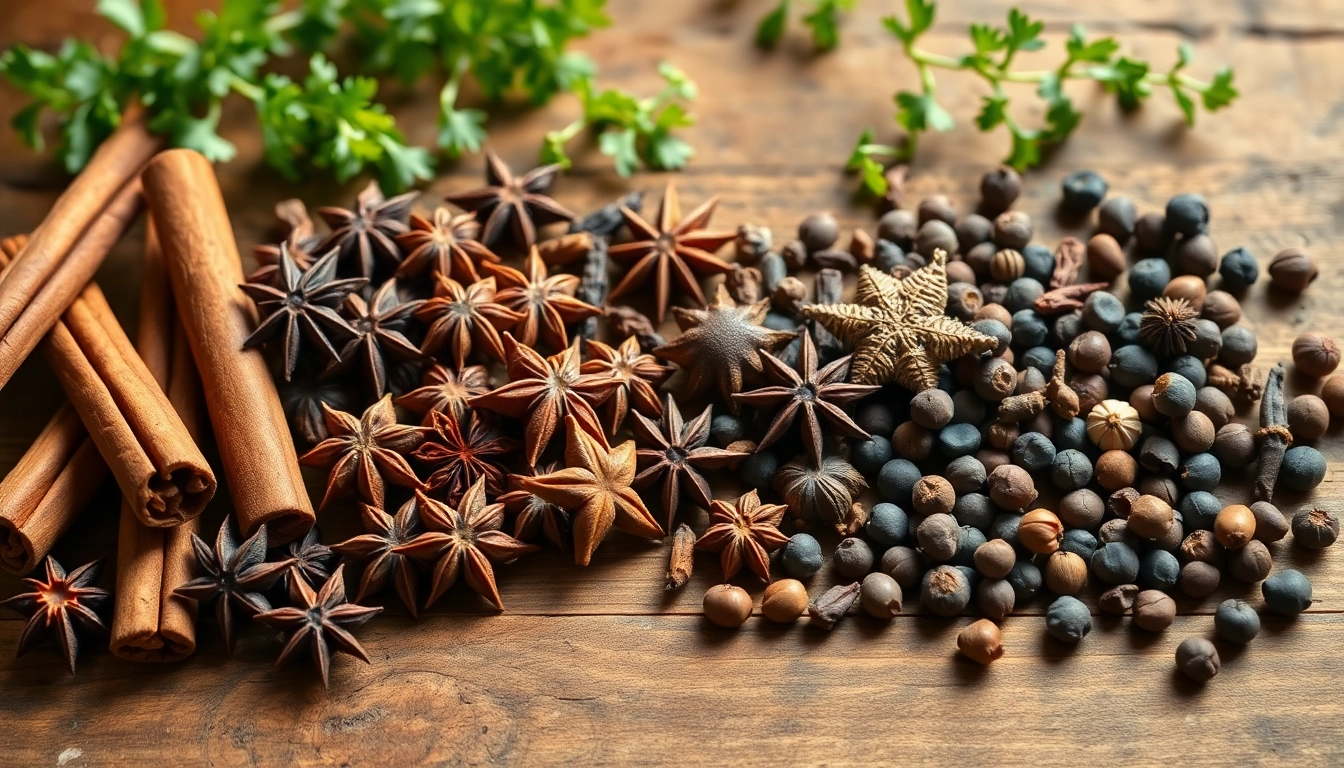
When it comes to cooking, the right spices can make or break a dish. Whole spices, in particular, have the ability to infuse your meals with a deeper, more vibrant flavor compared to pre-ground varieties. Not only do they retain their essential oils and flavors longer, but they also offer an aromatic intensity that transforms the simplest of dishes into culinary masterpieces.
If you’re looking to take your cooking to the next level, incorporating whole spices is a must. In this article, we’ll introduce you to seven Whole Spices that will elevate your culinary creations and provide you with a sensory experience that’s unforgettable. From aromatic cinnamon to bold star anise, these spices will forever change the way you cook.
Why Choose Whole Spices?
Before diving into the specifics, let’s discuss why whole spices should be an essential part of your spice rack. When spices are ground, they lose their flavor quickly because their oils are exposed to air. Whole spices, on the other hand, have a sealed structure that locks in the oils, keeping their natural aromas and flavors intact for a much longer period.
The beauty of whole spices is that they offer freshness and potency that ground spices simply can’t match. Whether you toast them, grind them fresh, or add them whole to your dishes, whole spices offer a depth and complexity of flavor that will make your cooking stand out.
Let’s take a closer look at seven whole spices that will instantly enhance your cooking.
1. Cinnamon Sticks: Sweet, Warm, and Versatile Whole Spices
Cinnamon is a staple in kitchens around the world. Known for its sweet, warm flavor, whole cinnamon sticks have the ability to transform both sweet and savory dishes. Cinnamon is more complex when used whole, offering a richness and depth that ground cinnamon can’t replicate.
How to Use Cinnamon Sticks:
- In Soups and Stews: Add a cinnamon stick to soups, curries, or braised meats for a comforting, aromatic flavor.
- In Desserts: Use cinnamon sticks in fruit-based desserts like apple pies, poached pears, or baked apples. They also pair wonderfully with chocolate in cakes or brownies.
- In Beverages: Cinnamon sticks make a wonderful addition to hot beverages such as mulled wine, spiced cider, or even coffee.
A little goes a long way with cinnamon sticks, as they can infuse a rich, warm aroma into your dishes.
2. Cloves: Bold, Pungent, and Intensely Flavorful Whole Spices
Cloves have a bold, sweetly bitter flavor profile, and they are essential for adding depth to both savory and sweet dishes. Their strong aroma makes them a fantastic addition to marinades, spice blends, and baked goods.
How to Use Cloves:
- In Braised Dishes: Add whole cloves to beef, lamb, or chicken braises to enhance the richness of the meat.
- In Spices for Baking: Cloves are a must-have in spice cakes, gingerbread, and cookies, bringing a warm, fragrant flavor to sweet treats.
- In Spiced Beverages: Drop a few cloves into your hot beverages, such as mulled wine, chai tea, or even coffee, for a warm, aromatic infusion.
Cloves can be potent, so it’s best to use them sparingly. They’ll add a strong and comforting flavor that brings out the best in your dishes.
3. Cardamom Pods: Sweet, Citrusy, and Elegant Whole Spices
Cardamom is often called the “queen of spices” for good reason. Known for its sweet, citrusy, and slightly floral flavor, cardamom is an essential spice for both savory and sweet dishes. Its complexity shines through when used in whole form, and its freshness can completely change the flavor profile of a dish.
How to Use Cardamom Pods:
- In Desserts: Cardamom is perfect for spicing up rice pudding, cakes, and cookies, adding a unique, exotic flavor.
- In Spice Blends: Whole cardamom pods are a key ingredient in garam masala and chai spice blends. Crushing them before using them will release their essential oils and flavors.
- In Savory Dishes: Add cardamom pods to curries, soups, or pilafs for a touch of sweetness that complements spicy and savory ingredients.
Cardamom pods are great for infusing dishes with a delicate, aromatic sweetness that transforms your cooking.
4. Star Anise: Sweet, Licorice-Like, and Bold Whole Spices
Star anise has a distinctive star-shaped appearance and a unique, sweet licorice-like flavor that stands out in both sweet and savory dishes. While it has a bold flavor, it pairs beautifully with other spices and ingredients, making it a must-have for flavorful cooking.
How to Use Star Anise:
- In Stews and Braises: Star anise is commonly used in braised dishes, especially those with meats like pork or duck. It adds a layer of complexity that enhances the dish’s flavor.
- In Sweet Dishes: Add it to poached fruits, syrups, or desserts like pies and cakes to give them a rich, aromatic sweetness.
- In Beverages: Star anise is perfect for mulled wine, hot cider, or tea. It creates a sweet and fragrant infusion that’s ideal for cozy, cold weather drinks.
The strong, licorice-like flavor of star anise makes it perfect for dishes that need a bit of sweetness and warmth.
5. Black Peppercorns: Fresh, Sharp, and Essential Whole Spices
Black peppercorns are a kitchen essential. While pre-ground black pepper is commonly used, fresh black peppercorns have an unmatched sharpness and aroma. Whole peppercorns can be freshly cracked just before use, providing a more vibrant and intense flavor that enhances virtually every dish.
How to Use Black Peppercorns:
- In Almost Any Dish: Freshly cracked black pepper can be added to soups, stews, salads, and roasted vegetables to provide a sharp, peppery heat.
- In Spice Blends: Black peppercorns are an essential ingredient in spice blends like garam masala or curry powder. They bring heat and depth to the mixture.
- In Marinades: Whole peppercorns can be used in marinades for meat, poultry, and fish, infusing the proteins with a bold, spicy kick.
Fresh black peppercorns are a versatile spice that can be used in nearly every type of dish, adding a bit of heat and complexity.
6. Bay Leaves: Subtle, Earthy, and Aromatic Whole Spices
Bay leaves are often overlooked, but they are a subtle yet essential addition to many slow-cooked dishes. Their earthy, slightly bitter flavor provides depth and complexity, especially when added to long-simmering stews and braises.
How to Use Bay Leaves:
- In Soups and Stews: Add bay leaves to your soups, stews, and braises for an aromatic base flavor that complements meat, vegetables, and broths.
- In Rice Dishes: Drop a bay leaf or two into your rice cooker to infuse the grains with a subtle, herbal aroma.
- In Stocks and Broths: Bay leaves are a key ingredient in homemade stocks and broths, where they slowly release their oils as they simmer.
While bay leaves are typically removed before serving, they leave behind an unforgettable, savory flavor that enhances your cooking.
7. Nutmeg: Sweet, Warm, and Spicy Whole Spices
Nutmeg is a warm, sweet spice that adds a wonderful depth of flavor to both savory and sweet dishes. While it’s often used in baking, it also works beautifully in savory meals. Whole nutmeg is incredibly potent, and it’s best used freshly grated to capture its intense, aromatic flavor.
How to Use Nutmeg:
- In Desserts: Nutmeg is perfect for pies, cakes, cookies, and custards. It pairs especially well with pumpkin and apple desserts.
- In Beverages: Freshly grated nutmeg can be added to eggnog, hot chocolate, or coffee for a comforting, spiced flavor.
- In Savory Dishes: Nutmeg is used in creamy dishes like béchamel sauce, mashed potatoes, or in stews and soups with squash or root vegetables.
Nutmeg’s sweet, spicy warmth is a must-have in any kitchen, especially when you use it whole and freshly grated.
Conclusion: Unlock the Full Potential of Your Dishes with Whole Spices
Using whole spices in your cooking is one of the easiest ways to elevate your meals and bring out the full potential of your dishes. From the sweet warmth of cinnamon sticks to the bold, licorice-like flavor of star anise, these whole spices offer unmatched freshness and aroma. They’ll transform your cooking from ordinary to extraordinary, adding complexity, depth, and unforgettable flavor to every meal.
So next time you’re in the kitchen, skip the pre-ground options and reach for the whole spices. You’ll be amazed at how they can completely transform your cooking and create a sensory experience that will delight your taste buds.
Frequently Asked Questions
- How do I store whole spices to keep them fresh?
Whole spices should be stored in a cool, dry place in airtight containers, away from direct sunlight. Proper storage can keep them fresh for several months, allowing you to enjoy their full flavor for a long time. - Can I use whole spices in place of ground spices?
Yes! Whole spices can easily replace ground spices in recipes. Just remember that whole spices tend to be stronger, so you may need to use a smaller quantity. - How do I extract the flavor from whole spices?
To release the maximum flavor, you can toast whole spices in a dry pan, crush them, or simply add them whole to your dishes. Crushing or grinding the spices right before use will ensure their essential oils are fully released. Our website is your ultimate source of valuable information.





